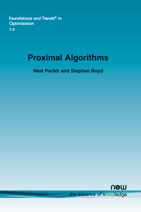Proximal Algorithms
By Neal Parikh, Stanford University, USA, npparikh@cs.stanford.edu | Stephen Boyd, Stanford University, USA, boyd@stanford.edu
Abstract
This monograph is about a class of optimization algorithms called proximal algorithms. Much like Newton’s method is a standard tool for solving unconstrained smooth optimization problems of modest size, proximal algorithms can be viewed as an analogous tool for nonsmooth, constrained, large-scale, or distributed versions of these problems. They are very generally applicable, but are especially well-suited to problems of substantial recent interest involving large or high-dimensional datasets. Proximal methods sit at a higher level of abstraction than classical algorithms like Newton’s method: the base operation is evaluating the proximal operator of a function, which itself involves solving a small convex optimization problem. These subproblems, which generalize the problem of projecting a point onto a convex set, often admit closed-form solutions or can be solved very quickly with standard or simple specialized methods. Here, we discuss the many different interpretations of proximal operators and algorithms, describe their connections to many other topics in optimization and applied mathematics, survey some popular algorithms, and provide a large number of examples of proximal operators that commonly arise in practice.
Proximal Algorithms
Proximal Algorithms discusses proximal operators and proximal algorithms, and illustrates their applicability to standard and distributed convex optimization in general and many applications of recent interest in particular. Much like Newton’s method is a standard tool for solving unconstrained smooth optimization problems of modest size, proximal algorithms can be viewed as an analogous tool for nonsmooth, constrained, large-scale, or distributed versions of these problems. They are very generally applicable, but are especially well-suited to problems of substantial recent interest involving large or high-dimensional datasets. Proximal methods sit at a higher level of abstraction than classical algorithms like Newton’s method: the base operation is evaluating the proximal operator of a function, which itself involves solving a small convex optimization problem. These subproblems, which generalize the problem of projecting a point onto a convex set, often admit closed-form solutions or can be solved very quickly with standard or simple specialized methods.
Proximal Algorithms discusses different interpretations of proximal operators and algorithms, looks at their connections to many other topics in optimization and applied mathematics, surveys some popular algorithms, and provides a large number of examples of proximal operators that commonly arise in practice.
